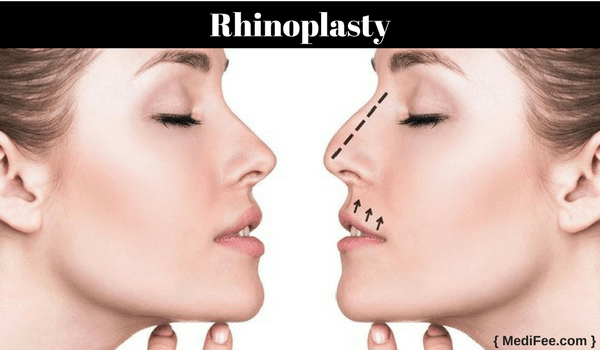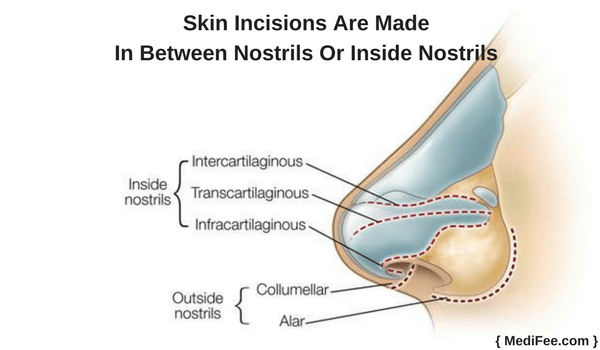Rhinoplasty
Listed below is the step by step procedure of rhinoplasty:
- What is Rhinoplasty ?
- Why is Rhinoplasty Required?
- Pre-operative Preparation
- Day Before Surgery
- Procedure Day
- Methods/Techniques of Rhinoplasty
- Post Procedure
- Risks and Complications
- FAQs
What is Rhinoplasty ?
Rhinoplasty is the cosmetic procedure for refining the nose shape and correcting it for improving one's appearance. In common language, a rhinoplasty is known as a “nose job.†Rhino means nose and plasty means to shape. Hence, rhinoplasty essentially means a procedure to shape the nose.

Why is Rhinoplasty Required?
People opt for rhinoplasty for a variety of reasons; medical as well as cosmetic. There are people who undergo a rhinoplasty if they have a structural defect in their nose due to any accident they faced. Congenital defects also can be cured through a rhinoplasty. Breathing problems are treated many times through this procedure. When no medical reasons are involved, rhinoplasty is also done when people are simply dissatisfied with the appearance of their nose.
Pre-operative Preparations
- You need to undergo fasting blood sugar test before undergoing rhinoplasty.
- A complete blood count and Partial Thromboplastin Time (PTT) is also ordered. The PTT is a test for assessing the blood's ability to clot.
- A nasal CT scan is also ordered by the doctor for observing the nasal lining.
- Health history will be asked by your doctor in detail. You won't be fit for surgery if you have any bleeding disorders.
- A physical examination is also done in order to observe the insides of the nose and the course of reshaping it.
- The doctor also photographs the nose from various angles for referring during surgery.
- Smoking has the capacity to alter the surgical outcomes, so it needs to be stopped 2-3 weeks in advance in order to have a successful outcome from surgery
Day Before Surgery
- You are expected not to eat or drink anything 8 hours prior to surgery.
- You also need to discontinue blood thinning medications, if you are on any.
Procedure Day
On the procedure day, you need to arrive in the hospital or clinic well before time. You will be made to fill out forms with the relevant medical information and also the consent form giving your approval for undergoing the surgery. Before the surgery commences, you will be instructed to change into a hospital gown.
Methods/Techniques of Rhinoplasty
To commence the surgery, a general anesthesia is given to the patient. The procedure is performed using incisions that are made in between nostrils or inside nostrils.

Post Procedure
After shifting you to the recovery room, the doctor will place a metal or plastic splint which is used for making the operated nose stay in shape while you rest. The splint may have to be kept in the same place for a week ahead. You will be kept under observation for few hours till the discharge happens.
Dos and Don'ts after Rhinoplasty Surgery
- Strenuous activities: Make sure to refrain from strenuous activities such as running, climbing, aerobics and jogging.
- Going out in sun: Avoid exposure to sun-rays as the rays have the capability to cause discoloration of skin around the nose.
- Showers: Avoid showering and take baths instead of showers while you have bandages on your nose.
- Use ice-packs: Remember to use ice-packs for reducing swelling around the nose and also its discoloration.
- Blowing your nose: Do not blow your nose even if you feel stuffy.
- Fiber-rich diets: Eat high-fiber foods, such as fruits and vegetables, to avoid constipation. Constipation can cause you to strain, putting pressure on the surgery site.
- Expressions: Refrain from laughing or smiling too hard so as not to stretch those facial muscles.
- Brushing: Brush your teeth carefully and gently.
- Clothing: Wear clothes that can be buttoned up, instead of those that need to worn through your head.
- Glasses: Avoid putting pressure on your nose by not resting the glasses on your nose when not in use for at least four weeks after the surgery.
Risks and Complications
A rhinoplasty has very few risks and complications. However, persistent flow of mucus or blood, difficulties in breathing properly, an asymmetrical nose structure and damage to blood vessels in nose are few very minor risks the patient should keep in mind.
FAQs
- Is rhinoplasty surgery safe for teens?
A. Doctors suggest that girls should be at least 15 at the time of undergoing a rhinoplasty or nose job. Boys should wait for a few more years till the nose develops properly. Studies show that rhinoplasty is one of the most popular cosmetic surgeries among teenagers. It is important that surgeons have a healthy discussion with parents of teenagers who wish to undergo a rhinoplasty. Doctors also ought to make sure that the decision to undergo rhinoplasty is a well thought out one rather than from the pressure of looking good or adhering to fashion.
- Am I a right candidate for a rhinoplasty?
A. Yes, if you have excessively flared up nostrils, a crooked nose, a nose that is too large for your face, or a distorted nose because of an injury or accident.
- How is rhinoplasty different from septoplasty?
A. Although, both of these surgeries essentially have the same crux of improving functioning of nose and also its appearance, both procedures have a difference. A deviated septum can be treated with the help of septoplasty. Septoplasty is considered a medical procedure while rhinoplasty is a cosmetic one.
- Is rhinoplasty an outpatient procedure?
A. Yes, a rhinoplasty is essentially an outpatient procedure. The patient is discharged from hospital the same day.
- Will I need to have any post-procedure touch-ups?
A. Only about 15 percent of rhinoplasty operations require touch-up procedures.
- When will I be able to see the results?
A. The results are not instant, in fact your nose will lose swelling gradually. As the swelling gradually disperses, your new nose will start to become visible properly. Majority of the swelling will go away by about 3 months.
- How long should I wait before considering revision rhinoplasty?
A. Most surgeons recommend waiting for at least 1 year before going in for a revision surgery. Tissues need time to heal and also the swelling needs to go away too. Revision surgery is a serious affair. Hence, a lot of thought and discussion needs to be done before actually scheduling a revision procedure.

